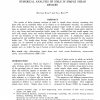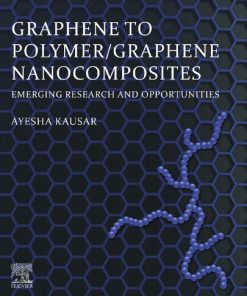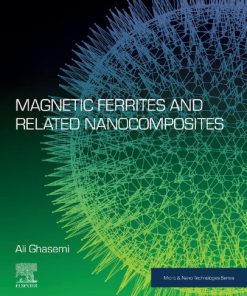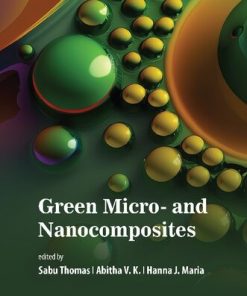Nanocomposites 1st edition by N B Singh 1000636690 9781000636697
$50.00 Original price was: $50.00.$25.00Current price is: $25.00.
Nanocomposites 1st edition by N B Singh – Ebook PDF Instant Download/DeliveryISBN: 1000636690, 9781000636697
Full download Nanocomposites 1st edition after payment.

Product details:
ISBN-10 : 1000636690
ISBN-13 : 9781000636697
Author : N B Singh
Nanocomposites are composite materials that have dimensions less than 100 nm in at least one of their phases, offering a higher surface-to-volume ratio. They are high-performance materials, exhibit unusual properties, and are considered as materials of the 21st century. In this book, experts from the field discuss the basic concepts, synthesis, characterization, properties, and applications of nanocomposites. The book is helpful for researchers, professional engineers, students, and those associated with a variety of disciplines of both academia and industry in seeking an understanding of what has been recently done in the field and the challenges related to it.
Nanocomposites 1st Table of contents:
1. Introduction to Nanocomposites
1.1 Introduction
1.2 Classification of Nanocomposites
1.3 Synthesis of Nanocomposites
1.4 Characterization of Nanocomposites
1.5 Properties of Nanocomposites
1.6 Applications
References
2. Nanocomposites: Types and Various Methods of Synthesis
2.1 Introduction
2.2 Types of Nanocomposites
2.3 Ceramic Matrix Nanocomposites
2.4 Metal Matrix Nanocomposites
2.5 Polymer Nanocomposites
2.6 Preparation Methods of Polymer Nanocomposites
2.7 Sol–Gel Synthesis Method
2.8 Melt Intercalation
2.9 Conclusion
References
3. Characterization of Nanocomposites
3.1 Introduction
3.2 Characterization Techniques for Nanocomposites
3.2.1 X-Ray Diffraction (XRD)
3.2.2 Microscopic Techniques: SEM/AFM/TEM
3.2.3 Thermal Stability
3.3 Characterization of Different Nanocomposites
3.3.1 Characterization of Nanocomposite Films of PVK/PVC-SiC
3.3.2 γ-Fe2O3 Dispersed Natural Rubber Composite
3.3.3 Calcium Silicate Hydrate (C-S-H)-Polymer Nanocomposite (C-S-HPN)
3.4 Conclusion
References
4. Carbon-Based Nanocomposites
4.1 Introduction
4.2 Graphene for Removal of Heavy Metals and Dyes
4.3 CNT Nanocomposite Application
4.4 Activated Carbon Nanocomposites
4.5 Conclusion
Acknowledgment
References
5. Core–Shell Nanocomposites
5.1 Introduction
5.1.1 Various Morphological NPs
5.1.2 Classification of Core–Shell NPs
5.1.3 Fabrication Methods for Core–Shell NPs
5.1.4 Significance of Core–Shell NPs
5.1.5 Scope
5.2 Various Types of Core–Shell Nanocomposites
5.3 Conclusions
Acknowledgments
References
6. Citric Acid–Assisted Inexpensive Semi-wet Combustion Synthesis and Characterization of Ultrafine LiFe0.95Ti0.05PO4 and LiFePO4 Polycrystalline Materials
6.1 Introduction
6.2 Experimental Procedure
6.2.1 Material Synthesis
6.2.2 Material Characterization
6.3 Result and Discussion
6.4 Conclusions
Acknowledgments
References
7. Magnetic Properties of Nanocomposites
7.1 Introduction
7.2 Magnetic Measurements and Magnetic Parameters of Nanocomposites
7.2.1 Magnetic Measurements
7.2.2 Magnetic Parameters of Nanocomposites
7.3 Nanocomposites Based on Magnetically Functionalized Carbon Nanotubes
7.4 Metal Matrix Nanocomposites
7.5 Polymer Matrix Nanocomposites
7.6 Ceramic Nanocomposites
7.6.1 Ceramic Nanocomposites Having Fe and Co
7.6.2 Ceramic Nanocomposites Having Only Fe
7.6.3 Ceramic Nanocomposites Having Only Ni
7.6.4 Spinel–Perovskite Structured Nanocomposites
References
8. Optical Properties of Nanocomposite Materials
8.1 Introduction
8.2 Optical Properties
8.2.1 Absorption and Transmittance
8.2.2 Luminescence
8.2.3 Nonlinearity
8.3 Metal Matrix Nanocomposites
8.4 Metal Oxide Matrix Nanocomposites
8.5 Polymer Matrix Nanocomposites (PMNC)
8.6 Ceramic Matrix Nanocomposites (CMNC)
8.7 Conclusion
References
9. Dielectric and Ferroelectric Studies of 0.5Ba0.8Sr0.2TiO3·0.5CaCu3Ti4O12 Nanocomposite Fabricated by the Combination of Solid State and Chemical Route
9.1 Introduction
9.2 Experimental
9.3 Result and Discussions
9.4 Conclusions
Acknowledgments
References
10. Dielectric Properties of Barium Titanate Nanocomposites
10.1 Introduction and Background
10.2 Synthesis Methods, Physiochemical Characterization, and Dielectric and Ferroelectric Properties
10.3 Future Perspectives
Acknowledgments
References
11. Nanocomposites and Their Sensing Properties
11.1 Introduction
11.2 Classification of Nanocomposites
11.2.1 Classification of Nanocomposites Based on Matrix Material
11.2.2 Classification of Nanocomposites Based on Reinforcement
11.3 Synthesis of Nanocomposites
11.4 Sensing Properties of Nanocomposites
11.4.1 Ceramic Matrix Nanocomposites
11.4.2 Metal Matrix Nanocomposites
11.4.3 Polymer Matrix Nanocomposites
References
12. Polymer Nanocomposite for Detection of Heavy Metal Ions
12.1 Introduction
12.2 Preparative Methods
12.3 Source and Toxicity
12.4 Methods for Metal Detection
12.5 Optical Methods
12.6 Electrical Methods
12.7 Conclusion
References
13. Use of Nanocomposites as Photocatalysts
13.1 Introduction
13.1.1 Photocatalysis
13.1.2 Uses of Photocatalysis
13.2 Nanocomposites
13.2.1 Applications of Nanocomposites
13.3 Recent Researches on Nanocomposites
13.3.1 Quinoline Oxidative Degradation by CuO/MCM- 41 Photocatalyst
13.3.2 Aqueous Phase Decontamination of Triclosan (Antifungal Agent) through UiO-66/CdIn2S4 Nanocomposites
13.3.3 Bisphenol A Photocatalytic Degradation and Photoelectrochemical Water Splitting by a Composite Photocatalyst for Plasmonic Metal/Semiconductor
13.3.4 Plasma Enhanced Bi/Bi2O2CO3 Heterojunction Photocatalyst
13.3.5 Ag-AgX-Zinc Oxide-rGO (X = Cl and Br) Nanocomposite for Enhanced Visible-Light Driven Photocatalysis
13.3.6 Photocatalytic Degradation of Sulfamethoxazole Drug Using F-Pd Co-doped Titanium Dioxide Nanocomposites
13.3.7 Chitosan-Zinc Sulfide Nanoparticles Photocatalytic Degradation Efficacy for Azo Dyes
13.3.8 Great Photocatalytic Output of CdS-SnS-SnS2/rGO under Visible Light
13.3.9 Enhanced Catalytic and Photocatalytic Properties of t-ZrO2/γ-Fe2O3 Supported AgPt Nanoparticles
13.3.10 Solar-Enhanced Nanosubstrate AlZinc Oxide@ Carbon for Textile Wastewater Remediation
13.3.11 Surface of Ta2O5 Decorated with Ta3B2 Nanodots for Increased Photocatalytic Activity
13.3.12 WO3/CNT Heterojunction Nanocomposite to Degrade Pharmaceutical Wastewater
13.3.13 Highly Degradation of Organic Dyes by Ag3VO4/ WO2.72 Nanocomposites
13.3.14 Photocatalytic Degradation of Acephate Pesticide
13.3.15 Photocatalytic Degradation and Magnetic Separation by NiFe2O4/MWCNTs/Zinc Oxide Hybrid Nanocomposite
13.3.16 Manufacture of Silver Iodide/Graphitic Carbon Nitride Nanocomposites
13.3.17 Photodegradation of Rhodamine B Dye by Zinc Stannate : Tin Oxide (ZTO:SnO2) Nanocomposite Photocatalysts
13.3.18 Hydrogen Evolution by the Photocatalyst Pt/La0.02Na0.98TaO3 Nanocomposite
13.3.19 Fabrication of Self-Healing Nanocomposite Hydrogels
13.3.20 Heterojunction of the Self-Cleaning Isotype g-C3N4 for Successful Photocatalytic Reduction of Uranium (VI)
13.4 Photocatalysts Spinel Ferrite Nanoparticles (SF-Nanoparticles) and Spinel Ferrite Nanocomposites (SF-Nanocomposites)
13.4.1 Introduction
13.4.2 Structure of Spinel Ferrite Nanoparticles
13.4.3 Properties and Applications of Spinel Ferrite Nanoparticles
13.4.4 Advantages of Spinel Ferrite Nanoparticles
13.4.5 Influence of pH of Zero Point Charge (pHzpc) on Adsorption of Anions and Cations
13.4.6 Synergistic Photocatalytic Activity
13.4.7 Photocatalytic Application of Spinel Ferrite Nanoparticles and Spinel Ferrite Nanocomposites for Wastewater Remediation
13.4.8 Mechanism of Contaminant Degradation
13.4.9 Dye Degradation
13.4.10 Degradation of Phenol and Phenol Derivatives
13.4.11 Antibiotics
13.4.12 Photocorrosion Reduction
13.4.13 Recent Researches on Spinel Ferrite Photocatalysts
13.5 Graphene Oxide Supported Semiconductors-Based Photocatalysts
13.5.1 Introduction
13.5.2 Significance of Photocatalysts Dependent on Graphene Oxide/Semiconductors
13.5.3 Basic Principle of Photocatalysis
13.5.4 Structure of Graphene Oxide
13.5.5 Applications of Graphene Oxide Mediated Photocatalysts
13.5.6 Recent Advancements on Graphene Oxide as Photocatalyst
13.6 Plasmonic Nanophotocatalysts for Hydrogen Production
13.6.1 Introduction
13.6.2 Production of Hydrogen Gas Using Titanium Dioxide
13.6.3 Splitting Water by Using Solid Solution GaN:ZnS
13.6.4 Photocatalysts Separate Water by Using Noble Metal Oxide
13.6.5 Hydrogen Development and the Reduction of Nitrogen Compounds into Amines
13.6.6 Recent Advances in Plasmonic Nanophotocatalysts for the Production of Hydrogen
13.6.7 Concluding Remarks
References
14. Clay Supported Titanium Dioxide Nanocomposites as Photocatalysts
14.1 Introduction
14.2 Removal of Organic Pollutants by Heterogeneous Photocatalysts
14.3 Titanium Dioxide as an Extremely Investigated Photocatalyst
14.4 Disadvantages of Using Titanium Dioxide as Photocatalyst
14.5 Overcoming the Limitations
14.6 Clay: A Promising Support for Titanium Dioxide Photocatalyst
14.7 Types of Clays Used as Supports of Titanium Dioxide
14.8 Clay
14.8.1 Formation of Clay
14.8.2 Color of Clay
14.8.3 Types of Clay
14.8.4 Structure of Clay
14.9 Origin of Clay
14.10 Smectite Mineral Structure
14.11 Cationic or Anionic Surface Clays
14.12 Nanocomposites of Titanium Dioxide with Different Clays
14.12.1 Titanium Dioxide/Mt Nanocomposites
14.12.2 Titanium Dioxide/Bentonite Nanocomposites
14.12.3 Titanium Dioxide/Kaolinite Nanocomposites
14.12.4 Titanium Dioxide/Halloysite Nanocomposites
14.12.5 Titanium Dioxide/Palygorskite and Titanium Dioxide/Attapulgite Nanocomposites
14.13 Function of Clay in Boosting Titanium Dioxide Photoactivity
14.13.1 Textural Differences
14.13.2 Large Surface Area and Volume of Pores
14.13.3 The Optical Properties
14.13.4 Influence of Optical Transparency
14.13.5 Interaction of Clay Surface with Photogenerated Electrons and Holes
14.13.6 Electrostatic Interactions of Clay with Photogenerated Charge Carriers
14.14 Recent Trend in the Use of Clay to Improve the Titanium Dioxide Photocatalytic Reaction
14.15 Recent Advances in Decolorization of Dyes by Clay/Titanium Dioxide Systems
14.16 Conclusion
Acknowledgment
References
15. Fractal-Based Nanocomposites
15.1 Introduction
15.2 Summary of Fractal-Based Nanocomposites
15.3 Future Scenario
Acknowledgment
References
16. Biodegradable Polymer Nanocomposites in Food Packaging
16.1 Introduction
16.2 An Overview on Biodegradable Polymer Nanocomposites
16.3 Preparation Methods
16.4 Testing of Packaging Materials
16.5 Mechanical Testing
16.6 Gas Permeability
16.7 Specific Tests
16.8 Application in Food Packaging
16.9 Hard Packaging
16.10 Flexible Packaging
16.11 Active Packaging
16.12 Conclusion and Future Outlook
References
17. Bioinspired Superhydrophobic Nanocomposite Materials: Introduction, Design, and Applications
17.1 Introduction
17.2 Fundamentals of Superhydrophobicity
17.2.1 Wetting Theories (Static Contact Angle)
17.2.2 Contact Angle Hysteresis
17.3 Nanocomposite Materials
17.4 Methods for the Synthesis of Superhydrophobic Nanocomposite
17.4.1 Top-Down Synthesis
17.4.2 Bottom-Up Synthesis
17.5 Applications of Superhydrophobic Nanocomposite Surfaces
17.5.1 Oil-Water Separation
17.5.2 Anti-icing Coating
17.5.3 Anti-corrosion
17.5.4 Self-Cleaning
17.5.5 Anti-fouling
17.5.6 Anti-fogging
17.5.7 Water-Resistant Fabrics/Textiles
17.6 Limitations of Superhydrophobic Surfaces
17.6.1 Structure Stability and Durability Issues (Mechanical/Chemical Stability)
17.6.2 Scalable and Cost-Effective
17.6.3 Environmentally Friendly
17.6.4 Multifunctional Superhydrophobic Coating/ Surfaces
People also search for Nanocomposites 1st:
bi2te3 nanocomposites
types of nanocomposites
define nanocomposites
application of nanocomposites
advanced nanocomposites
Tags: Nanocomposites, composite materials, dimensions less, materials, exhibit unusual properties
You may also like…
Science
Graphene to Polymer/ Graphene Nanocomposites: Emerging Research and Opportunities 1st edition












